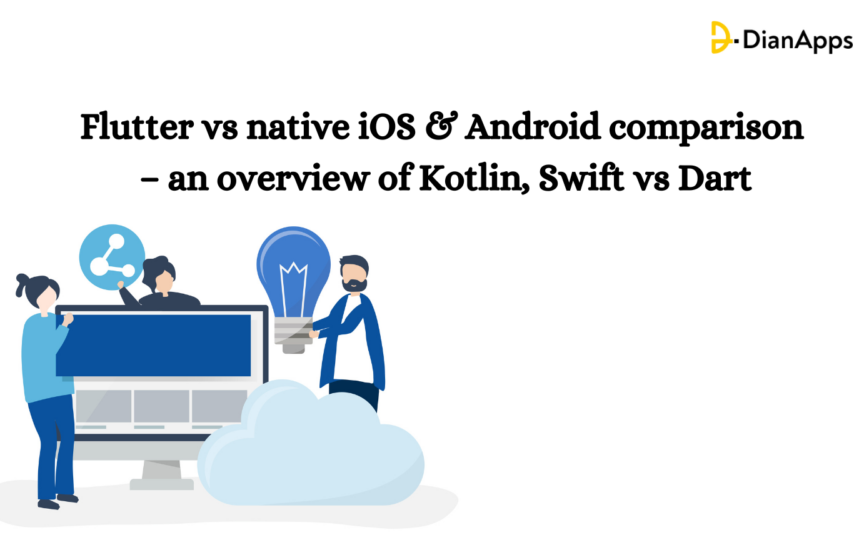We know the major differences between Native apps and cross-platform frameworks such as Flutter. One is extremely old and well-known among developers, and the other is a 2017-launched open-source UI toolkit that has captured huge user-base attention for its intuitive features and constant technology updates.
Flutter Vs native iOS and Android, Which one to adopt for your web or app development services? The answer lies in this blog comparison.
From weighing the pros and cons to evaluating the costs of both frameworks, we shall be highlighting every aspect of the two platforms. We will also look at the effectiveness of the programming languages Kotlin Vs Swift Vs Dart to help you pick the best for your business project.
Let’s start with knowing the statistics in general.
Kotlin, Swift, Dart– General Statistics
Before we walk through the details of each programming language’s functionality and differences, let’s find a few critical statistics that includes the popularity of each language along with its hierarchy or position in terms of its usage.
- Did you know that the average spent time by mobile app users is 92.5% while 7.5% is for web browsers?
- With vigorous mobile app adoption and usage, users are ready to pay more to experience the changing technology. Due to this, the app store earned approximately $320,000 every minute according to a 2021 survey.
- As per studies, the number of Android apps is more than 3.5 million apps.
- While the Apple store calculates an estimated 2.2 million apps for iOS app development services.
- The irony here is that Apple company still generates higher revenue from its apps than Android apps.
Let’s have a closer look at what programming languages and frameworks are popular in mobile app development services.
Kotlin
- In 2022, the majority of firms aim to move their apps to one of the top 3 languages, which is Kotlin.
- Developers chose Kotlin as their preferred language by a margin of 63% in the Stack Overflow study for 2022.
- In 2021, 2 million professionals used Kotlin at least once, and 1 million professional developers used it as one of their main programming languages.
Swift
- Objective-C has mostly been supplanted by Apple’s Swift language, which was created in 2014 and is more dependable and simpler to comprehend. According to a poll by JetBrains, 76% of developers have Swift proficiency, 13% have Swift plus Objective-C proficiency, and 11% have solely Objective-C proficiency.
- Swift is 8.4 times quicker on average than Python and 2.6 times faster than Objective C.
- Swift developers outnumber Objective-C developers (1.6 million) by about a million (2.1 million).
Dart
- According to Stack Overflow’s 2022 Developer Survey, Dart is presently the 16th most popular programming language.
- About 6.54 percent of the over 72,000 respondents indicated they used Dart, compared to 9.16 percent who said they used Kotlin (15th), 9.32 percent who said they used Rust (14th), and 11.15 percent who said they used Go (13th).
- At 4.91 percent, Apple’s Swift programming language came in at number 19. JavaScript, which was employed by 65.36 percent of respondents, was the language that was most frequently employed.
Swift, Kotlin, Dart – short overview
Even while Swift, Kotlin, and Dart are still relatively young languages, given what they can offer, developers are already favoring them for creating native (Kotlin and Swift) or cross-platform (Flutter and Dart) apps.
But why precisely are they so well-liked? Before getting into the technical intricacies, let’s give a quick overview of each technique.
Sure! Here’s a short overview of Swift, Kotlin, and Dart, three popular programming languages used for different purposes:
1. Swift:
Swift is a programming language developed by Apple for building iOS, macOS, watchOS, and tvOS applications. It was designed to be modern, safe, and efficient.
Swift is known for its readability and ease of use, making it an excellent choice for both beginners and experienced developers.
It has powerful features like optional, closures, and generics, which help in writing expressive and clean code. Swift is also interoperable with Objective-C, allowing developers to use both languages within the same project.
2. Kotlin:
Kotlin is a statically-typed programming language that runs on the Java Virtual Machine (JVM). It was developed by JetBrains and has gained significant popularity in recent years, especially for Android app development.
Kotlin offers modern language features, improved syntax, null safety, and enhanced Java interoperability. It is fully compatible with existing Java codebases, allowing developers to seamlessly integrate Kotlin into their projects.
Kotlin’s concise and expressive syntax helps reduce boilerplate code and makes development more efficient.
3. Dart:
Dart is a general-purpose programming language developed by Google. It is primarily used with the Flutter framework for building cross-platform mobile, web, and desktop applications.
Dart combines object-oriented and functional programming paradigms and provides features like optional typing, async/await, and a reactive programming style.
It has a just-in-time (JIT) compiler for development and an ahead-of-time (AOT) compiler for production, enabling fast execution and excellent performance. Dart’s main strength lies in its ability to create visually appealing and responsive user interfaces using Flutter.
Each of these languages has its strengths and areas of application, so the choice depends on the platform and specific requirements of the project you’re working on.
Native app development or cross-platform development?
The choice between native app development and cross-platform app development depends on various factors, including project requirements, target audience, development resources, time constraints, and budget. Here’s an overview of each approach:
1. Native App Development:
Native app development involves building applications specifically for a single platform using the platform’s native programming languages and tools. For example, Swift or Objective-C for iOS, Java or Kotlin for Android, and C# for Windows. Native apps offer the following advantages:
- Performance: Native apps generally have better performance as they can directly access the device’s features and hardware.
- User Experience: Native apps can provide a seamless user experience by following platform-specific UI guidelines and utilizing native UI components.
- Access to Platform-Specific Features: Native development allows leveraging the full range of platform-specific features and APIs.
However, native development has some drawbacks:
- Development Effort: Building separate codebases for each platform requires more development effort, as the code and UI need to be implemented separately for iOS and Android.
- Cost: Native development can be costlier since it requires different skill sets and dedicated development resources for each platform.
- Longer Development Time: Developing and maintaining separate codebases for each platform can increase the overall development time.
2. Cross-Platform Development:
Cross-platform development involves building applications that can run on multiple platforms using frameworks and tools that allow code sharing between platforms. Some popular cross-platform frameworks include Flutter, React Native, and Xamarin. Cross-platform development offers the following advantages:
- Code Reusability: Cross-platform frameworks enable sharing of a significant portion of code between different platforms, reducing development time and effort.
- Faster Development: Building a single codebase for multiple platforms can result in faster development cycles and quicker time-to-market.
- Cost Efficiency: With code sharing, cross-platform development can be more cost-effective compared to maintaining separate native codebases.
However, cross-platform development also has some considerations:
- Performance: While cross-platform frameworks strive for good performance, they may not always match the performance of native apps, especially for computationally intensive or graphically demanding applications.
- Platform Limitations: Cross-platform frameworks rely on bridging technologies to access platform-specific features, which may not provide the same level of functionality or immediate support for new platform features as native development.
- UI Consistency: Achieving pixel-perfect UI consistency across platforms can be challenging due to platform-specific design guidelines and UI component variations.
Ultimately, the choice between native app development and cross-platform development depends on the specific needs of your project, including performance requirements, budget, timeline, and the importance of platform-specific features and user experience.
It’s essential to evaluate these factors and choose the approach that aligns best with your project goals and constraints.
Features characteristic of each technology
Here are some features characteristic of Kotlin, Swift, and Dart:
Kotlin:
1. Interoperability: Kotlin is fully interoperable with Java, allowing developers to leverage existing Java code, libraries, and frameworks seamlessly.
2. Null Safety: Kotlin has built-in null safety features, reducing the chances of null pointer exceptions by distinguishing nullable and non-nullable types at the language level.
3. Extension Functions: Kotlin allows the creation of extension functions, which enable developers to add new functions to existing classes without modifying their source code.
4. Coroutines: Kotlin provides built-in support for coroutines, allowing developers to write asynchronous code in a sequential and more readable manner.
5. Smart Casts: Kotlin’s smart casts enable automatic type casting based on conditions, eliminating the need for explicit type checks and casts.
Swift:
1. Safety and Optionals: Swift was designed with a focus on safety, and it introduces options to handle the absence of a value explicitly, reducing the occurrence of null-related errors.
2. Value Types: Swift emphasizes the use of value types, such as structs and enums, which are passed by value, promoting immutability and reducing mutability-related bugs.
3. Closures: Swift supports closures, which are self-contained blocks of code that can be passed around and called later. Closures enable powerful functional programming patterns.
4. Protocol-Oriented Programming: Swift promotes protocol-oriented programming, allowing the definition of protocols with associated methods and properties, fostering code reuse and flexibility.
5. Playgrounds and Swift REPL: Swift provides interactive playgrounds and a Read-Eval-Print Loop (REPL) environment, enabling developers to experiment and test code snippets in real time.
Dart:
1. Just-in-Time (JIT) and Ahead-of-Time (AOT) Compilation: Dart supports both JIT and AOT compilation. During development, Dart applications can be run and hot-reloaded using the JIT compiler, while for production, the code can be compiled to highly optimized native code using the AOT compiler.
2. Hot Reload: Dart’s hot reload feature allows developers to make changes to the code and see the results instantly without restarting the application, making the development process more iterative and efficient.
3. Asynchronous Programming: Dart has built-in support for asynchronous programming using async/await syntax, making it easier to write concurrent and non-blocking code.
4. Flutter Framework: Dart is the primary language used with the Flutter framework, which enables cross-platform development for mobile, web, and desktop applications, providing a rich set of UI components and tools.
5. Generators: Dart includes support for generators, which are functions that can be paused and resumed, allowing developers to write memory-efficient code when dealing with large collections or streams.
These are just some of the notable features of Kotlin, Swift, and Dart. Each language offers a broader range of features and capabilities that contribute to their respective ecosystems and make them suitable for different use cases.
Conclusion
Which of those three technologies is best for your purposes in the Flutter vs. Native debate, and who wins? As you can see, everything is based on your expectations and aspirations. Over cross-platform software, a native app created using Kotlin or Swift offers several benefits, including better performance and support for OS-specific functionality. Contrarily, the Flutter framework makes it considerably quicker to create apps for several platforms utilizing a single codebase and a selection of widgets.
Consider your requirements and company goals while selecting the best one for your subsequent app development project.
If you want professional guidance on this subject, keep in mind that there are leading Flutter app development company who will be delighted to hear about your needs and then give recommendations on how to create a new app that looks and functions precisely how you want it to.
So if you’re having trouble deciding how to build your new app, get in touch with a service provider to come up with a solution together.







